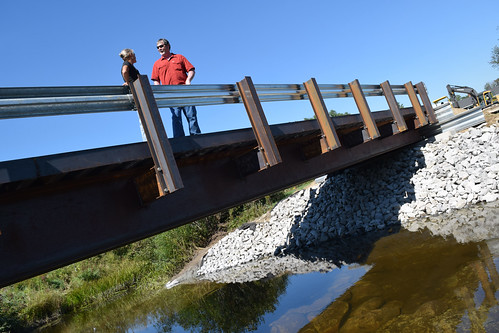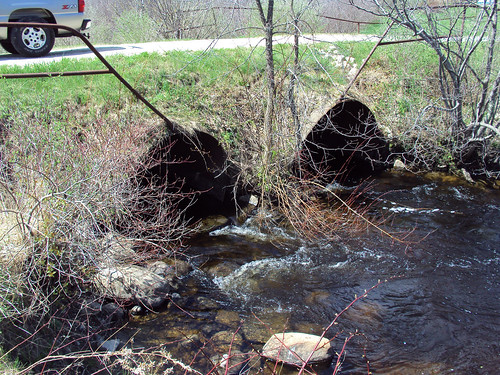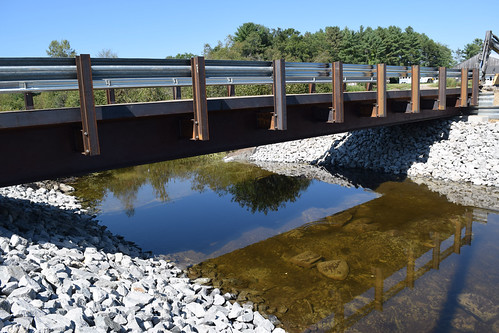
A just-completed project that restored a fish passage in southern Maine may have another benefit – preventing an environmental disaster on important salmon-spawning streams.
A new bridge that now crosses the Swan Pond Creek at the Al Dube Quarterhorse Farm in York County was the culmination of a year-long quest by the Saco River Salmon Club and Hatchery and the Natural Resources Conservation Service (NRCS) to rehabilitate a section of the creek for fish passage and rearing of juvenile salmon.
The one-piece bridge replaces two failing culverts on the livestock farm’s driveway, and returns the waterway to a natural and fish-friendly course, which, ultimately, feeds into the Atlantic Ocean.
“The previous bridge was a set of old retrofitted boiler tanks that were used as culverts and were failing badly,” said NRCS District Conservationist Wayne Munroe.

Rick LaRiviere, president of the Saco River Salmon Club and Hatchery, contacted Munroe after he discovered the failing culverts. Debris was partially blocking the stream in front of the culverts. But LaRiviere was more concerned that the badly rusted and warped culverts would collapse and completely block the waterway. A blockage would mean disaster for several varieties of fish, including native Atlantic salmon.
LaRiviere encouraged property owner Cynthia Hodak to apply for assistance through NRCS’ Environmental Quality Incentives Program to replace the culverts with a prefabricated, 60-foot bridge. “The benefit of this type of bridge application is that it greatly reduces the amount of instream work, making it much less invasive to the ecosystem,” LaRiviere said.
The project faced a roadblock, however. In June 2015, NRCS discovered a seemingly bottomless layer of blue marine sediment at the potential bridge site. This ‘blue goo’ would make the structure of the bridge less secure. And options other than a bridge were either too expensive or would not allow construction of a fish passage.
When removal of the failing culverts began crews discovered another complication – the crossing was in much worse shape than expected with substantial cracks, buckled support pipes and leaks in the culverts. During a high-water flood these conditions could wash the culverts and surrounding fill downstream and destroy a significant amount of wildlife habitat.
Now, thanks to NRCS funding and technical expertise and the diligence of the Saco River Salmon Club and Hatchery, the Swan Pond Creek now flows fast and clear under the new bridge.
“The water quality has definitely improved. Now if there is a major storm event we have bought some mitigation credit so the channel can handle more capacity and won’t threaten the bridge,” Munroe said. “That gives the landowner assurance that she can continue to operate the farm with confidence and site-access even when a big storm happens.”
Farm owner Hodak said she was impressed with the improvements the project made to her farm and the natural habitat.
“This is amazing,” Hodak said, while watching a pair of fallfish swim lazily under the new bridge. “It has done many things, but it has opened up this piece of the brook so the fish can move around better. I had no idea that there were smallmouth bass and trout, and crawfish in here.”
Munroe and LaRiviere say that this project and the removal of other barriers along the Swan Pond Creek have restored access to crucial spawning and rearing habitat, and improved water quality, for salmon upstream and downstream.
“Immediately, we restored the free access for the fish to move upstream by removing that barrier,” Munroe said. “You see nice, crystal-clear water, a much-improved stream channel and direct enhancement to the habitat.”
Munroe is proud of the partnership project. “When you see that the salmon are already moving upstream because of this project, that is the measure of success.”
EQIP provides financial and technical assistance to agricultural producers in order to address natural resource concerns and deliver numerous environmental benefits, to include improved wildlife habitat.

